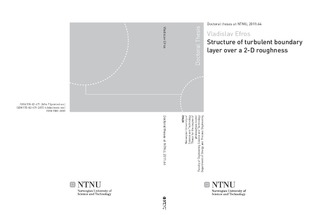| dc.description.abstract | The roughness is an important parameter in wall-bounded flows, as most surfaces are rough. The main effect of the roughness is to increase the drag as the near wall is affected by the roughness. In recent years a lot of efforts has been used to find out what effect has the roughness on the outer layer. In other words is there any differences in outer layer, boundary layer or channel flow, between rough and smooth-surface?
Jimenez (2004) suggests that for δ/k > 40 there are no differences, in agreement with Townsend’s hypothesis, the roughness merely acts to increase the surface stresses, without changing the structure in the flow.
This was challenged by Krogstad et. al (1999) who showed, for boundary layer over 2−D roughness, there is a difference in the outer layer due to the roughness. However for a channel flow Krogstad et. al (2004) has found no differences. The main impediment is how to obtain a reliable estimate for the friction velocity, uτ, which is the main scaling parameter of principal interest. In channel flow the uτ may be obtained directly from the stream-wise pressure gradient. A common technique for boundary layer over smooth surface is the Clauser chart. This method is subjected to large uncertainties for rough surface, because the number of unknowns is increased from one, Cf , for smooth surface to three, (Cf , _, the shift in origin and Δu/uτ shift in velocity), for rough surface. The need for an independent measurement of the wall shear stress has led to the present work.
A floating-balance has been designed to obtain the shear stress on the rough surface. The balance was tested in channel flow, adverse pressure gradient flow and zero pressure gradient boundary layer and the velocity field was investigated using a two-component LDA system. The results showed that the shear stress, from balance, was underestimated by ∼ 4%. Turbulent boundary layer is a complicated nonlinear system; Clauser (1956) compared it with a black box. A better understanding of this system may be obtained by changing one of its inputs and to examine its output. An experimental investigation on the response of a turbulent boundary layer to sudden change in roughness, from smooth to rough, using floating balance to measure the shear stress is also a part of the present work. The structure of the turbulent boundary layer over 2 − D roughness was invesitigated using LDA and PIV system. All the moments up to third order were determined from the LDA measurements. From the PIV measurements twopoint correlations in x − y plane were obtained. The effect of large scales on the features of the flow-using POD was also investigated | nb_NO |
